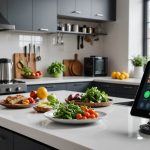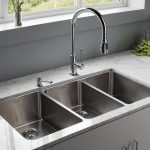Revolutionizing Meal Management: How Smart Home Assistants Like Alexa and Google Home Transform Your Diet Planning in the Kitchen
In the heart of every home, the kitchen has long been a space where tradition and innovation intersect. With the advent of smart home technology, particularly smart home assistants like Amazon Alexa and Google Home, the way we manage meals is undergoing a significant transformation. Here’s a deep dive into how these intelligent systems are revolutionizing meal planning, cooking, and the overall kitchen experience.
The Rise of Smart Kitchens
Smart kitchens are no longer a concept of the future; they are a reality that many homeowners are embracing today. At the core of this transformation are smart home assistants that integrate seamlessly with various kitchen appliances and devices.
This might interest you : Selecting Kitchen Cabinet Handles: A Key Strategy for Preventing Cross-Contamination
Voice Assistants: The Central Hub
Devices like Amazon Alexa and Google Home have become the central hubs of smart kitchens. These voice assistants use artificial intelligence (AI) to respond to voice commands, controlling everything from playing music to managing your kitchen appliances.
For instance, you can use Alexa or Google Assistant to preheat your oven, adjust the cooking time, or even order groceries. Here’s how these voice assistants can streamline your kitchen experience:
In the same genre : Smart Kitchen Designs to Curb Unhealthy Late-Night Snacking Temptations
- Voice-Controlled Appliances: Smart ovens and cooktops can be controlled via voice commands. Imagine telling your oven to preheat to 400°F while you’re still in the living room, or asking your smart cooktop to adjust the heat settings without having to physically touch it.
- Recipe Suggestions: These assistants can suggest recipes based on the ingredients you have on hand. For example, if you have chicken, vegetables, and rice, Alexa might suggest a simple chicken stir-fry recipe.
- Meal Planning: Voice assistants can generate weekly meal plans and organized grocery lists. Apps like Mealime and Yummly integrate with these assistants to suggest recipes based on your family’s preferences and dietary restrictions.
Efficient Meal Planning with Smart Technology
Meal planning is one of the most time-consuming tasks in the kitchen, but smart home assistants and their integrated apps are making it significantly easier.
Personalized Meal Plans
Smart meal planning apps, such as Mealime and Yummly, use AI to generate meal plans tailored to your family’s tastes and dietary needs. Here’s how it works:
- Ingredient Tracking: Smart refrigerators, like those from Samsung and LG, can track the expiration dates of your ingredients and suggest recipes based on what you have available.
- Grocery Lists: Voice assistants can add items to your grocery list with simple voice commands. For example, you can tell Alexa to add milk and eggs to your shopping list.
- Dietary Considerations: These apps take into account any dietary restrictions or preferences, such as gluten-free, vegan, or low-carb diets.
Streamlining Grocery Shopping
Grocery shopping is another area where smart home technology is making a significant impact.
- Automated Lists: Smart home assistants can create and manage your grocery lists automatically. You can add items as you think of them, and the list will be synced across all your devices.
- In-Store Navigation: Some apps, integrated with voice assistants, can even guide you through the store, ensuring you don’t forget any items on your list.
Smart Appliances: The Backbone of Efficient Cooking
Smart kitchen appliances are the backbone of efficient cooking in the smart kitchen. Here’s how they are transforming the cooking experience:
Smart Ovens and Cooktops
Smart ovens and cooktops are equipped with advanced features that make cooking more efficient and precise.
- Automatic Adjustments: These appliances can automatically adjust cooking times and temperatures based on the type of food you’re cooking. For example, a smart oven can adjust the cooking time for a roast chicken based on its weight and moisture level.
- Remote Control: You can control these appliances remotely using your smartphone or voice commands. Imagine preheating your oven while you’re on your way home from work.
Smart Refrigerators
Smart refrigerators are more than just storage units; they are now integral to meal planning and grocery management.
- Internal Cameras: Some smart refrigerators come with internal cameras that allow you to see what’s inside even when you’re not at home. This feature helps you plan meals and avoid buying duplicate items.
- Recipe Suggestions: These refrigerators can suggest recipes based on the ingredients you have on hand, reducing food waste and making meal planning more efficient.
Energy Efficiency and Eco-Friendly Practices
Smart home technology is not only about convenience but also about being energy efficient and eco-friendly.
Energy-Efficient Appliances
Smart kitchen appliances are designed to be energy efficient, reducing your energy consumption and bills.
- Optimized Settings: Smart thermostats and appliances can optimize their settings based on your usage patterns and real-time data, ensuring that energy is used efficiently.
- Automated Controls: Voice assistants can automate tasks like turning off lights or appliances when not in use, further reducing energy waste.
Reducing Food Waste
One of the significant benefits of smart kitchen technology is the reduction of food waste.
- Expiration Date Tracking: Smart refrigerators track the expiration dates of your ingredients and suggest recipes to use them before they go bad.
- Meal Planning: By generating meal plans based on available ingredients, these systems help ensure that you use up all the food you have, reducing waste.
Practical Insights and Actionable Advice
Here are some practical tips to help you get the most out of your smart kitchen:
Setting Up Your Smart Kitchen
- Start Small: Begin with a few smart appliances and gradually expand your smart kitchen ecosystem.
- Choose Compatible Devices: Ensure that all your devices are compatible with your voice assistant to achieve seamless integration.
Maximizing Efficiency
- Use Voice Commands: Utilize voice commands to control your appliances and manage your meal plans.
- Regularly Update Software: Keep your devices and apps updated to ensure you have the latest features and improvements.
Balancing Technology and Design
- Aesthetic Integration: Choose smart appliances that fit your kitchen’s aesthetic to maintain a cohesive look.
- User-Friendly Interfaces: Opt for devices with user-friendly interfaces to ensure that everyone in the household can use them comfortably.
Real-World Examples and Success Stories
Here are a few real-world examples of how smart home technology is transforming kitchens:
The Connected Kitchen
Imagine a kitchen where all appliances communicate with each other seamlessly. For instance, as you enter the kitchen, the lights adjust, the coffee maker starts brewing, and the oven preheats for your breakfast. This level of interconnectivity is now possible with smart home technology.
The Smart Homeowner
Meet Sarah, a busy working mom who uses her smart kitchen to manage her family’s meals. She uses Alexa to generate meal plans, add items to her grocery list, and control her smart oven. Sarah’s smart refrigerator tracks the expiration dates of her ingredients and suggests recipes, ensuring that she never forgets what she has on hand.
The Future of Smart Kitchens
As technology continues to evolve, the possibilities for smart kitchens are endless.
Advanced AI Integration
Future smart kitchens will see even more advanced AI integration, where appliances can learn from user behaviors and adapt to meet their needs. For example, a smart cooktop might adjust its settings based on the dish you’re preparing, or a smart refrigerator could analyze your eating habits and automatically suggest meal plans.
Increased Interconnectivity
The future will also see increased interconnectivity between different areas of the home. Imagine a kitchen that adjusts its lighting and temperature based on the time of day and your health data from fitness trackers. This level of integration will create a truly automated and responsive living environment.
Smart home assistants like Alexa and Google Home are revolutionizing meal management in the kitchen by offering unparalleled convenience, efficiency, and personalization. From voice-controlled appliances to smart meal planning and energy-efficient practices, these technologies are transforming the way we cook and interact with our kitchens.
As Dr. Chrissann Ruehle, an AI consultant, notes, "By integrating these smart technologies into the family’s routine, one can create a more organized, efficient, and happy household, allowing more time for what truly matters – quality family moments."
In conclusion, embracing smart home technology in your kitchen is not just about adopting new gadgets; it’s about creating a more efficient, eco-friendly, and enjoyable cooking experience that enhances your daily life. So, take the leap and see how smart home assistants can transform your kitchen into a hub of innovation and convenience.






